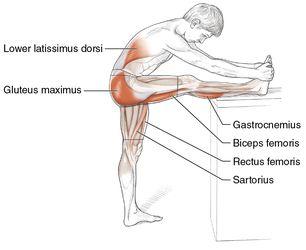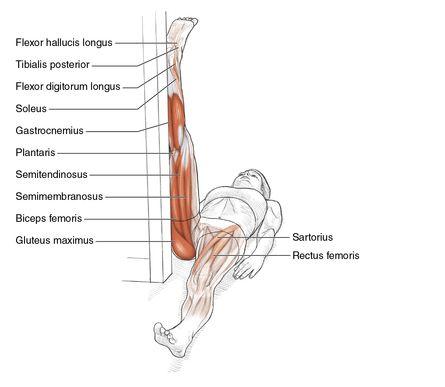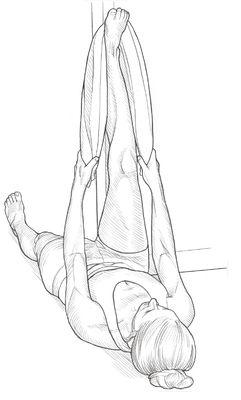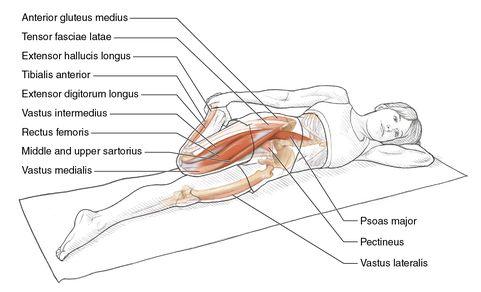Stretching Anatomy-2nd Edition (19 page)
Read Stretching Anatomy-2nd Edition Online
Authors: Arnold Nelson,Jouko Kokkonen
Tags: #Science, #Life Sciences, #Human Anatomy & Physiology

- Most-stretched muscles:
Right gluteus maximus, right semitendinosus, right semimembranosus, right biceps femoris, right erector spinae, lower right latissimus dorsi, right gastrocnemius - Less-stretched muscles:
Right soleus, right popliteus, right plantaris, right flexor digitorum longus, right flexor hallucis longus, right posterior tibialis, left sartorius, left rectus femoris
Stretch Notes
This is a more advanced stretch for those whose knee flexors are already more flexible than the average athlete. Be sure to select the right starting height for the table, bench, couch, or other stable object you will put your leg on. At the beginning of your stretching program, it is recommended to start at a lower height based on your state of flexibility and then periodically increase the height of the surface by several inches as your flexibility improves. Increasing the height of the surface by 1 to 2 feet (30 to 60 cm) above the hips as your flexibility improves will increase the stretch of these muscle groups. At this point, you will also start feeling a stretch to a portion of the front part of the left-leg muscle groups (sartorius; rectus femoris; vastus intermedius, lateralis, and medialis) as you increase the table to the highest possible height.
To maximize the stretch of the knee flexors, do not bend the knees, tilt the pelvis forward, or curve the back. In addition, bend the trunk straight forward as a single unit, keeping it centered over the right leg.
VARIATION
Raised-Leg Knee, Ankle, Shoulder, and Back Stretch
Grasping and pulling on the toes adds more muscles to the stretching process. This combination exercise stretches most of the posterior (back) body muscles at the same time. This naturally saves some time if your exercise time is limited. Follow steps 1 to 3. Once you are in the step 4 position, grasp the toes or the ball of the foot and pull the foot toward the knee.
Recumbent Knee Flexor Stretch
Execution
- Lie flat on your back in a doorway, with the hips placed in front of the doorframe.
- Raise the right leg and rest it on the doorframe. Keep the right knee straight and the left leg flat on the floor.
- Place the hands palms down on either side of the buttocks.
- Keeping the right leg straight, use the hands to slowly move the buttocks through the doorframe until you feel a stretch in the back of the leg.
- Repeat this stretch for the opposite leg.
Muscles Stretched
- Most-stretched muscles:
Right gluteus maximus, right semitendinosus, right semimembranosus, right biceps femoris, right gastrocnemius - Less-stretched muscles:
Right soleus, right popliteus, right plantaris, right flexor digitorum longus, right flexor hallucis longus, right posterior tibialis, left sartorius, left rectus femoris
Stretch Notes
When stretching the knee flexors, you must be careful of the lower back. If the lower-back extensor muscles are tight, they will limit the ability to perform most knee flexor stretches. As a result many people overstress the back. Also it is easy to tilt the pelvis forward or curve the back. Doing this can further harm the lower-back muscles. When you are lying down on your back, it is easier to maintain correct back positioning, and the floor provides additional back support. Thus, this exercise is the best knee flexor stretch to use when you have back problems.
Positioning your body in the right place for this stretch could take some extra time and effort, but once you are able to find the right position, it is an excellent stretch. To maximize the stretch of the knee flexors, do not bend the knees, tilt the pelvis forward, or round the back. Adjust the distance between the buttocks and the doorframe to increase or decrease the stretch. The closer the buttocks are to the doorframe, the greater the stretch. Once the buttocks cannot be positioned any closer to the doorframe, bending the right leg at the hip and moving the right leg toward the head can increase the stretch. It is also important to keep the left leg straight in front of you on the floor in order for you to get the maximal effect of this stretch. When reaching the maximal stretch limit, you will find that the quadriceps muscles on the left leg are getting stretched as well.
VARIATION
Recumbent Knee, Ankle, Shoulder, and Back Stretch
Using a towel to pull the toes downward increases the number of muscles being stretched. Follow steps 1 to 4. Once you feel the hamstrings being stretched, use the towel to pull the toes and foot down toward the floor. This combo exercise stretches most of the muscles on the back side of the body at the same time. In other words, you can work on multiple muscle groups, including the calf, hamstring, back, shoulder, and arm muscles, to a small degree. This naturally saves some time if your exercise time is limited.
Beginner Seated Knee Extensor Stretch
Execution
- Sit upright on a couch or bed, with the left knee bent at less than a 90-degree angle in front of you. The lateral side of the left leg should be flat on the surface and the left hip on the edge of the couch or bed.
- Balance the weight of your body over the left hip.
- Extend the right leg behind the torso, and touch the floor with the right knee. The lower right leg lies on the floor.
- Place the hands on the couch or bed to maintain balance.
- Move the hips slowly forward, if needed, for more stretch.
- Repeat this stretch for the opposite leg.
Muscles Stretched
- Most-stretched muscles:
Right vastus medialis, right vastus intermedius, right vastus lateralis, middle and upper right sartorius, right rectus femoris, right psoas major, right iliacus, right tensor fasciae latae - Less-stretched muscles:
Right pectineus, anterior right gluteus medius
Stretch Notes
The knee extensors, the quadriceps, are used for common actions such as standing, sitting, walking, running, and jumping. Strains and injuries of the quadriceps muscles and tendons are common among athletes 15 to 30 years old who are engaged in explosive activities. On the other hand, for people engaged in daily living activities, the average age for injuries to these muscles is 65. Muscle strains and tears usually happen when a muscle is stretched beyond its limit, tearing the muscle fibers. They frequently occur near the point where the muscle joins the tendon. The four main causes of quadriceps injuries are muscle tightness, muscle imbalance, poor conditioning, and muscle fatigue. The ease of performing this beginning-level stretch will hopefully motivate you to stretch these muscles, especially since it can be done while reading, watching TV, or just relaxing.
This is a beginner’s stretch for the quadriceps muscles. You can perform this stretch while sitting on the edge of a sofa or bed. The sitting position helps make the execution of this stretch more comfortable and relaxing. Place a pillow under the right knee for added comfort. Having the left leg in the bent position in front of you allows the stretch to be focused on the right leg’s quadriceps muscles. Extend the right leg back from the torso.
Moving your hips slowly forward allows you to monitor the amount of stretch you put on the quadriceps muscles. This stretch can increase in intensity as needed or desired. Simply try arching the back slightly while moving the hips in the forward direction. After maximizing this level of stretching, start using the more advanced stretches found in this chapter.
Intermediate Lying Knee Extensor Stretch
Safety tip Do not bring the heel all the way to the buttocks.
Execution
- Lie on the left side of the body.
- Bend the right knee, and bring the right heel to within 4 to 6 inches (10 to 15 cm) of the buttocks.
- Grasp the right ankle tightly, and pull the leg back close to your buttocks. However, do not bring the heel of the right ankle all the way to the buttocks.
- At the same time, push the hip forward.
- Repeat this stretch for the opposite leg.
Muscles Stretched
- Most-stretched muscles:
Right vastus intermedius, right rectus femoris, right psoas major, middle and upper right sartorius - Less-stretched muscles:
Right vastus medialis, left vastus lateralis, right tensor fasciae latae, right pectineus, right iliacus, anterior right gluteus medius, right tibialis anterior, right extensor digitorum longus, right extensor hallucis longus
Other books
If Nuns Ruled the World by Jo Piazza
Silent Hall by NS Dolkart
Finding Forever by Shriver, Michele
Carnal Series 1 - Carnal lesson by Harper Vonna
Dating the Guy Upstairs by Amanda Ashby
The Banshee's Revenge (The Banshee's Embrace Trilogy) by Richards, Victoria
Boxcar Children 56 - Firehouse Mystery by Warner, Gertrude Chandler, Charles Tang
Nightstruck by Jenna Black
Death on the Diagonal by Blanc, Nero
The Case of the Angry Actress: A Masao Masuto Mystery by Howard Fast





